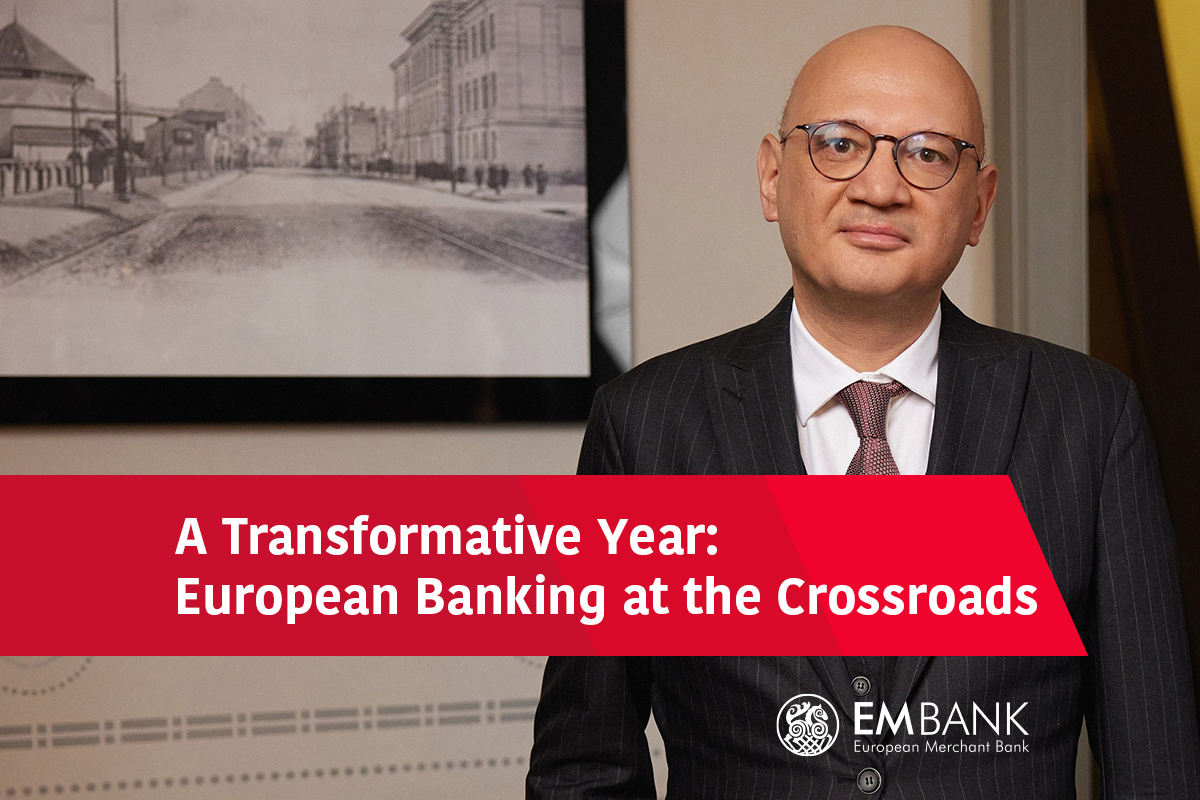As I perused the speeches, reports and opinions of Europe’s esteemed policymakers, economists and industry experts on the significant changes in the European banking ecosystem in 2024, mostly underscoring how we are at the crossroads in a transformative year, I could not help but wonder how we bankers have always loved such crossroads. As any history enthusiast would tell you, the origins of and inflexions in banking can be traced back to the civilizations that flourished at the crossroads of commerce and culture. How we will fare at this new junction remains to be seen, yet the initial signs inspire confidence.
Despite two banking shocks, increasing geopolitical conflicts and the climate crisis in 2023, European banking achieved an increased return on equity, reporting an average RoE of 10.9%, up from 7.68%. EU banks displayed capital resilience: the fully loaded CET1 ratio reached 15.7% in Q1 2023 and remained around 15.8% by the end of the year. Their total capital ratio was stable at around 19.6%, showing strong capital adequacy supported by retained earnings and regulatory measures.
2024 has been forecast to be a “soft landing” in short-term economic growth. Inflation has come down across the EU. The policy rates have not moved down yet but are expected to do so imminently. For the longer term, however, a survey of the financial landscape shows that European banking faces many challenges that could potentially reshape the sector significantly. The 2023 distress, with the involvement of Silicon Valley Bank and Credit Suisse, triggered a broader discussion about the banking industry’s stability worldwide. The two fevers have subsided thanks to timely and effective interventions, yet they have left their bitter aftertaste. In the interconnected economic body, they motivate our introspection and may galvanize the right changes if we are to stay healthy.
Regulatory Changes and Compliance
New regulations such as CRD6, CRR3, and the Digital Operational Resilience Act (DORA), not to forget MiCAR, are introduced to build systemic resilience against potential shocks stemming from climate crises, pandemics, war or cyber threats. Recent regulations demand higher capital adequacy, recalibrated risk management frameworks, and greater transparency, pushing banks to allocate more resources towards compliance and good governance.
CRD6 is a topic to be discussed in detail, but I should note here that “no-cross-border services from non-EU banks to EU clients” is a consequence of a more multipolar world. EU bodies direct global institutions to examine their EU footprint: consolidating their European business into one European entity or subsidizing in a “right-sized” manner.
Societal and Demographic Shifts
I agree with the view that European banks must act quicker in adapting to broader demographic shifts since the global financial transformation is not only new technology-driven but stems from new consumer demand, especially of Gen Z, for more digital, seamless, personalised, and responsive banking services. This shift calls for significant investment in renewal. The time for it is sooner rather than later.
The flip side is that European banks will not leave senior citizens behind. Those social segments who have not joined digital banking simply couldn’t access services otherwise. Finding branches to perform basic banking has become an issue. For example, older or more dispersed rural populations are relying increasingly on post offices or banking hubs in the UK. So, I expect financial inclusion and societal impact initiatives that can temper technology’s side effects to emerge from Europe.
Diminishing Net Interest Margins Leads To Cost Pressure
The traditional banking model highly depends on interest income derived from the spread between interest earned on loans and interest paid on deposits. However, the expected environment of lower interest rates on loans combined with competitive pressures to offer higher returns on deposits will squeeze those margins. This compression poses a significant threat to profitability, forcing all banks to explore alternative revenue streams and search for cost reduction measures or face a potential decline in financial health. Consultants would tell us that the best cost savings would come from smartly executed strategic investments.
Liquidity Concerns
The possibility of a recession in European economies, a late onset effect of anti-inflation measures just when they have proved successful, would be another pain point that might hamper the much-needed structural investments in European banking. Liquidity would become an issue again with a rising share of company loan defaults and insolvencies. The ability of banks to manage short-term obligations becomes critical in an environment where rapid shifts in depositor behaviour can occur. It requires diligent internal controls and proactively maintains adequate capital and liquidity buffers to deal with unexpected surges in demand. This sharper liquidity focus could limit banks’ structural transformation vision along with banks’ profitability search.
Fund Outflows to Money Markets
In 2023, there has been a significant outflow of funds from banks to perceived safer havens such as money markets, especially in the US but not insignificantly in Europe. Let us remember that it may not just be a temporary reaction but a recalibration of confidence in the traditional banking sector, which could have longer-lasting effects than legacy institutions might like to believe.
The Future Is Upon Us: A New Technological Infrastructure
90% of European banks are burdened with end-of-life IT systems for business-critical activities, which pose significant operational risks, including cybersecurity threats, inefficiencies, and an inability to compete with more technologically agile competitors, not only FinTechs in the EU area but US tech behemoths who present as the “bankers of the future”. Upgrading IT systems is costly and complex, requiring significant time and expertise to implement.
From a positive perspective, sometimes it is easier to change many things that must work in tandem than just focus on one aspect, like the tech itself. The nature of the new tech and AI tools might also make systemic overhauls much easier than imagined, making investment not only imperative but smoother compared to the previous paradigm. It is more viable with new hardware and software to invest more securely in third-party services, for example.
Risk Assessment in a Climate-Challenged World
Banks are called on to develop new risk models for our new settings, especially getting comfortable with working on multiple future risk scenarios, validating and calibrating them often, and not forgetting to assess indirect effects such as declining asset quality or competition for deposits.
Climate risk is declared the top risk in the next 5 years. The young generation also expects sustainable, environmentally friendly practices at every turn. This transition to sustainable economic practices will only be achieved with the key support of European banking, which will fund the new economy.
Transformation Through Collaboration with Fintech Institutions
I want to touch upon the role of fintech-friendly neo-banks such as our European Merchant Bank in this picture. Despite the competition it poses to the traditional banking model, I believe the rise of fintech presents a great opportunity for European banks. By embarking on their transformation through collaborations with fintech, legacy banks can and increasingly do leverage fintech’s agility to offer a wider range of services through Banking-as-a-Service (BaaS), reaching a broader audience. This scheme not only meets new customer needs but also creates new revenue streams for banks. Open Banking will add momentum to this partnership, allowing banks to share core functionalities securely with FinTechs. This requires a mindset shift, but the rewards are clear: A reinvented banking sector built on collaboration and innovation.
How is 2024 going so far?
In the first quarter of 2024, European banks displayed a robust overall performance with solid capitalization and improved liquidity, but there are early signs of deterioration of credit quality. Capitalisation is strong (CET1 ratio at 15.9%), and profitability remains high (RoE at 10.3%) due to rising interest rates. Liquidity is comfortable (LCR 167%, NSFR 127%) and supported by debt issuance. However, there are early signs of credit quality deterioration, with a slight increase in non-performing loans (1.9%) and stage-2 loans. Loan growth is subdued due to tighter lending standards and lower demand.
ECB is expected to decrease its interest rate in the latter part of 2024, which could impact profitability while geopolitical tensions and economic disruptions remain.
Conclusion
European banks are indeed at a crossroads. They face a complex array of challenges that call for innovative, thoughtful, and decisive responses even in the face of “radical uncertainty”. While the sector has shown resilience in the past, the magnitude of current pressures demands a strategic re-evaluation of existing business models.
It might involve embracing new technologies, revisiting customer engagement strategies, and even rethinking the very core of their traditional banking models. The path forward will likely be marked by those institutions that can turn these pressing challenges into opportunities for reinvention. Banks need to go beyond responding to immediate stakeholder demands. I believe many institutions will muster the confidence and resources to thrive proactively even in an increasingly digital, regulated, and uncertain future.
At the crossroads, though, bankers should feel familiar. The factors which I discussed with you above seem to conspire in convincing European banking to devise its own reinvention and walk into the future more nimbly, in a concerted effort, with an updated dynamic risk evaluation, a readiness to move with a multiverse of possible futures, and a shift to pivotal thinking. I believe European banking will adapt well and play a key role in directing new routes to flourish from the crossroads, energising the new economy.



